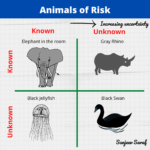Communicating risks to public from chemical or nuclear facilities is a major challenge. We notice this over and over again with EPA community-right-to-know, nuclear power plants and lately with the LNG facilities.
I want to focus on a critical aspect of this risk communication – winning the trust of the community.
There are two major cognitive social psychology principles one must understand while planning a risk communication program:
1. If an individual has strong initial impressions of a hazard, then subsequent evidence will be influenced by these beliefs. New evidence will appear reliable if it is consistent with initial impressions. And similarly, new evidence will be dismissed if it is contrary to initial impression.
For example, if you are talking about risks from LNG terminals and the neighbors are concerned about explosion hazards or terror threats, you cannot simply dismiss them. I have noticed in some of these meetings citizens raising question about hazards and some PR firm answers LNG is a clean energy source. Within a minute this evidence will be dismissed!You have to acknowledging the hazards/risks consistent with initial impressions and then present your strategy for minimizing risks.
Remember people receive information from media, talking to other people, news, blogs, radio and all these come into account in risk perception. Without complete knowledge of the system, such as LNG terminal, decisions of a person are based on beliefs concerning likelihood of uncertain events. And we know these likelihoods are minimal – now all you have to do is show what steps are being taken in order to reduce the likelihood.
2. If an individual lacks strong prior opinions about a hazard, their risk perception will be influence by HOW the information is presented.
As an example, if a patient is offered a treatment option with 70% chance of survival (as opposed to 30% chance of death) he is more than likely to accept the treatment. Framing the statistics in terms of living rather than dying changes risks perceived by the patient.
So what does all this mean in context of developing a risk communication or crisis communication plan:
- Realize you will have two distinct categories of people – people who have developed prior opinions and people who have no prior idea
- Plan your presentation for both these categories.
- For audience without a prior belief system educate them with past statistics.
- Audience who have a prior opinion you have to acknowledge the hazards and focus on risk mitigation measures
You can keep the above guidelines and now you have to decide
- What information to communicate
- How best to put across the information
- Who should communicate



